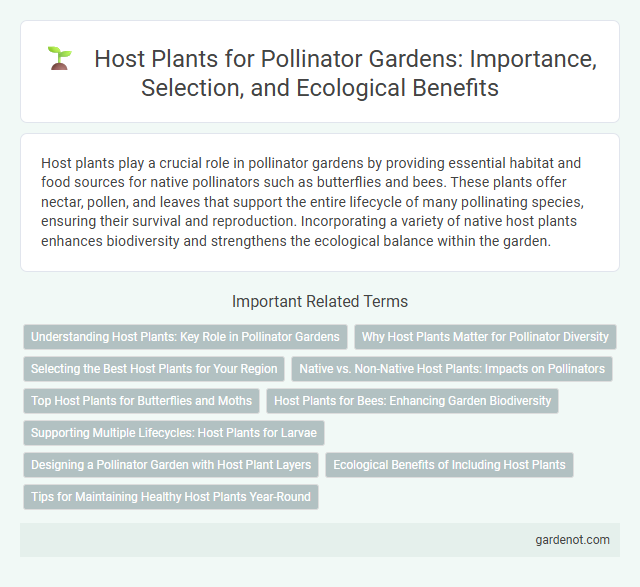Host plants play a crucial role in pollinator gardens by providing essential habitat and food sources for native pollinators such as butterflies and bees. These plants offer nectar, pollen, and leaves that support the entire lifecycle of many pollinating species, ensuring their survival and reproduction. Incorporating a variety of native host plants enhances biodiversity and strengthens the ecological balance within the garden.
Understanding Host Plants: Key Role in Pollinator Gardens
Host plants serve as essential resources for pollinator gardens by providing nourishment and habitat for specific insect species, especially caterpillars and butterflies. Understanding the relationship between host plants and native pollinators ensures the garden supports the full lifecycle of beneficial insects, promoting biodiversity and ecological balance. Selecting native host plants tailored to local pollinator species maximizes garden health and pollination success.
Why Host Plants Matter for Pollinator Diversity
Host plants are essential for sustaining pollinator diversity by providing specific food sources and breeding habitats crucial for the life cycles of various pollinator species. These plants support specialized pollinators, such as butterflies and bees, by offering nectar, pollen, and larvae nourishment, ensuring ecosystem balance and resilience. Incorporating native host plants in pollinator gardens promotes biodiversity and strengthens local pollinator populations, contributing to healthy pollination networks.
Selecting the Best Host Plants for Your Region
Selecting the best host plants for your region involves understanding local climate, soil conditions, and native pollinator species. Native plants such as milkweed in North America or verbena in tropical areas provide essential resources for caterpillars and butterflies, enhancing pollinator biodiversity. Incorporating region-specific host plants promotes healthy pollinator populations and supports ecological balance in your garden.
Native vs. Non-Native Host Plants: Impacts on Pollinators
Native host plants support local pollinator species by providing co-evolved nectar and pollen sources essential for their survival, enhancing biodiversity and ecosystem stability. Non-native host plants may offer nectar but often lack the specific chemical and structural traits required by native pollinators, leading to reduced pollination efficiency and potential disruption of local pollinator networks. Selecting native host plants in pollinator gardens promotes healthy populations of bees, butterflies, and other pollinators critical for pollination services and ecological balance.
Top Host Plants for Butterflies and Moths
Top host plants for butterflies and moths include milkweed (Asclepias spp.), essential for monarch caterpillars, and passionflower (Passiflora spp.), which supports several butterfly species like the Gulf fritillary. Oak trees (Quercus spp.) serve as critical hosts for numerous moth and butterfly larvae, providing important nourishment during their development. Native violets (Viola spp.) support the growth of fritillary butterflies, making these plants key components of pollinator gardens designed for lepidopteran conservation.
Host Plants for Bees: Enhancing Garden Biodiversity
Host plants for bees play a crucial role in enhancing garden biodiversity by providing essential nectar and pollen resources that support various bee species. Native plants such as goldenrod, purple coneflower, and milkweed are especially effective in attracting and sustaining solitary bees, bumblebees, and honeybees throughout their life cycles. Incorporating a diverse mix of flowering host plants adapted to local climates increases pollinator resilience and promotes a thriving ecosystem within pollinator gardens.
Supporting Multiple Lifecycles: Host Plants for Larvae
Host plants play a crucial role in supporting multiple lifecycles by providing essential nourishment and habitat for larvae of various pollinator species. These plants offer targeted food sources that cater specifically to the dietary needs of caterpillars and other larval stages, ensuring successful development into pollinators like butterflies and moths. Integrating diverse host plants in pollinator gardens enhances biodiversity and fosters a sustainable ecosystem for pollinator populations.
Designing a Pollinator Garden with Host Plant Layers
Integrating diverse host plant layers in pollinator garden design supports a wide range of pollinators by providing essential habitats and food sources for larvae and adult insects. Native trees, shrubs, and herbaceous plants create vertical complexity, enhancing ecological niches for butterflies, bees, and moths. Prioritizing region-specific host plants ensures successful pollinator reproduction and biodiversity conservation within the garden ecosystem.
Ecological Benefits of Including Host Plants
Host plants serve as essential food sources and breeding sites for pollinators like butterflies and bees, fostering biodiversity within pollinator gardens. By supporting the complete life cycles of pollinators, host plants enhance ecological resilience and promote healthy ecosystems. Integrating native host plants into pollinator gardens maximizes habitat value and contributes to the conservation of local pollinator species.
Tips for Maintaining Healthy Host Plants Year-Round
Regularly inspect host plants for pests and diseases to prevent infestations that can harm pollinators. Prune dead or damaged foliage during early spring and late fall to encourage robust growth. Maintain consistent watering schedules and enrich soil with organic compost to support nutrient uptake and promote year-round vitality of host plants.
Host plant Infographic

 gardenot.com
gardenot.com